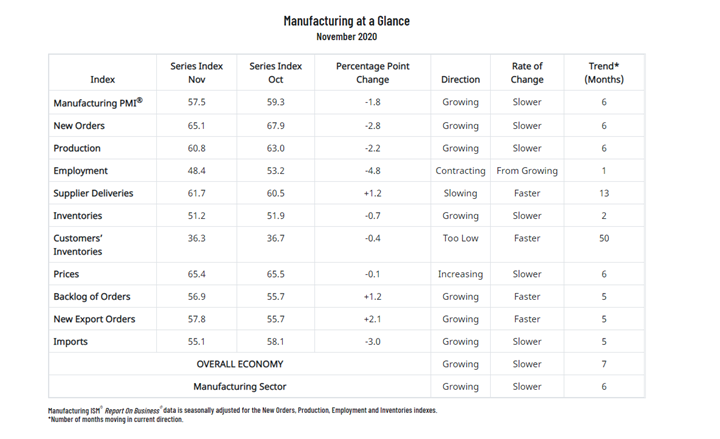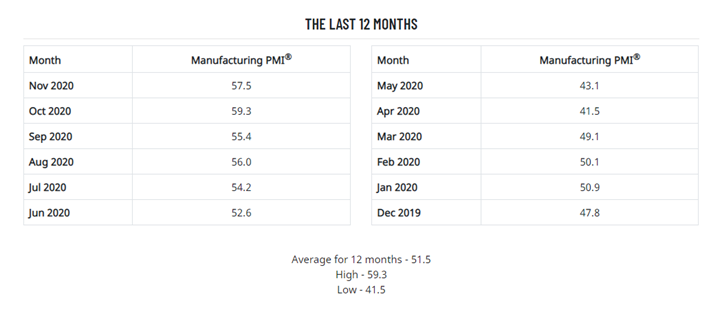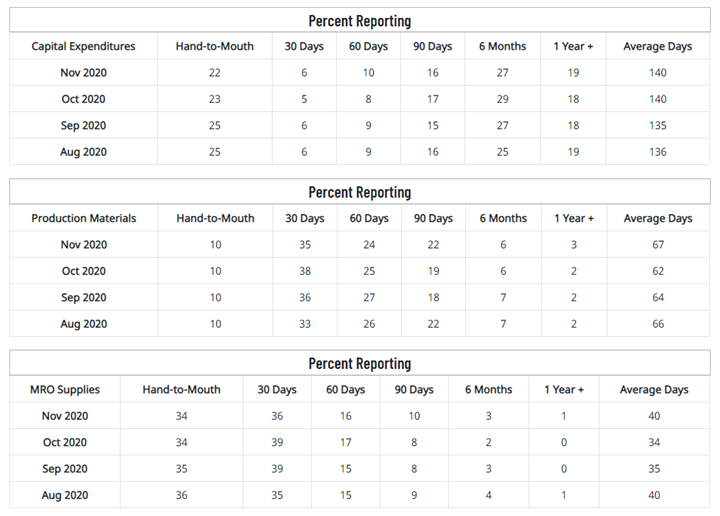KPI — December: State of the Manufacturing Sector

Economic activity in the manufacturing sector grew in November, with the overall economy securing a seventh consecutive month of growth, according to the nation’s supply executives in the latest Manufacturing ISM® Report On Business®. The November Manufacturing PMI® registered 57.5%, down 1.8 percentage points from the October reading of 59.3%.

The Report On Business® measures its data using the Purchasing Manager’s Index (PMI), which is an indicator of economic health in the manufacturing sector. A reading above 50% indicates that the manufacturing economy is generally expanding, while below 50% indicates that it is generally contracting. All data and analysis are courtesy of Institute for Supply Management.

“The manufacturing economy continued its recovery in November. Survey Committee members reported their companies and suppliers continue to operate in reconfigured factories, but absenteeism, short-term shutdowns to sanitize facilities and difficulties in returning and hiring workers are causing strains that will likely limit future manufacturing growth potential,” said Timothy R. Fiore, CPSM, C.P.M., Chair of the Institute for Supply Management® (ISM®) Manufacturing Business Survey Committee.
Furthermore, demand, consumption and inputs registered growth but at slower rates compared to October.
“Labor market difficulties, both current and anticipated, at panelists’ companies and their suppliers will continue to dampen the manufacturing economy until the coronavirus (COVID-19) crisis ends,” explained Fiore.
- Demand expanded, with the (1) New Orders Index growing at strong levels, supported by the New Export Orders Index expanding strongly; (2) Customers’ Inventories Index at its lowest figure since June 2010 (35.8%), a level considered a positive for future production; and the (3) Backlog of Orders Index expanding at a slightly faster rate compared to the previous three months.
- Consumption (measured by the Production and Employment indexes) contributed negatively (a combined seven-percentage point decrease) to the Manufacturing PMI® calculation, with five of the top six industries continuing with moderate to strong output expansion. The Employment Index contracted after a single month of growth, primarily due to an inability to attract and retain direct labor.
- Inputs—expressed as supplier deliveries, inventories and imports—continued to indicate input-driven constraints to production expansion, at higher rates compared to October, as indicated by minimal gains in inventory levels and a softening of imports. Input improvement stalled compared to October and contributed marginally to the Manufacturing PMI® calculation. (The Supplier Deliveries and Inventories indexes directly factor into the Manufacturing PMI®, while the Imports Index does not.) Prices continued to expand at higher rates, reflecting a clear shift to seller pricing power.
Sixteen of 18 manufacturing industries reported growth in November: Apparel, Leather & Allied Products; Nonmetallic Mineral Products; Textile Mills; Wood Products; Electrical Equipment, Appliances & Components; Fabricated Metal Products; Plastics & Rubber Products; Primary Metals; Chemical Products; Machinery; Computer & Electronic Products; Paper Products; Miscellaneous Manufacturing; Transportation Equipment; Furniture & Related Products; and Food, Beverage & Tobacco Products. The two industries reporting contraction in November are: Printing & Related Support Activities; and Petroleum & Coal Products.
Commodities Up in Price: Acetone; Aluminum (6); Aluminum Products (2); Ammonia; Brass Products; Copper (6); Corrugate (2); Corrugate Boxes; Freight; Lumber (5); Natural Gas; Plastic Resins (3); Plywood Products; Polyethylene Resins (2); Polyurethane Foam; Polypropylene (5); Polyvinyl Chloride (2); Precious Metals (5); Propylene Glycol; Rubber Products; Soybean Products (2); Steel (4); Steel—Cold Rolled (3); Steel—Hot Rolled (3); Steel—Stainless; Steel Products (3); and Zinc Products
Commodities Down in Price: Caustic Soda (2)
Commodities in Short Supply: Aluminum Products (2); Corrugate Boxes; Disinfectant and Cleaning Supplies; Electrical Components (2); Personal Protective Equipment (PPE)—Gloves (9); PPE—Masks; Steel—Hot Rolled; and Steel Products (2)
Note: The number of consecutive months the commodity is listed is indicated after each item. *Indicates both up and down in price.
What Respondents Are Saying
- “Suppliers are still experiencing labor shortages resulting in component constraints. However, we’re seeing life from customers, so there’s a positive outlook moving into the first quarter of 2021.” (Computer & Electronic Products)
- “Production issues for petrochemicals are getting resolved after a very active hurricane season. That is helping balance supply and demand.” (Chemical Products)
- “The resurgence in COVID-19 cases is adding strain on our Tier-1 and Tier-2 suppliers. Multiple suppliers mentioned that finding new people is an issue with the COVID-19 situation. And there is a learning curve for new [supplier] hires, impacting production efficiency at their place.” (Transportation Equipment)
- “We are getting a lot more COVID-19 hits in our factories and sending employees home for 14 days to quarantine if they were in close proximity to individuals that tested positive. We have had to shut down production lines due to lack of staffing. Cost of goods sold [COGS] is much higher than normal due to labor and production inefficiencies.” (Food, Beverage & Tobacco Products)
- “Jet fuel being down in consumption really hurts the refining market.” (Petroleum & Coal Products)
- “We will finish out the fourth quarter very strong. Customers have increased demand and 2021 is expected to continue to grow.” (Fabricated Metal Products)
- “Sales have been steady, but down 30% year-over-year. Work hours for production are going up, but we still have several on lay-off. Starting to see some inflationary pressure on materials.” (Furniture & Related Products)
- “Business continues to be strong, with significant backorders. Suppliers have struggled to hire people, as we have to support the increased business. We are seeing significant delays in getting parts and materials from China through U.S. ports, especially [at the Port of] Long Beach. Material costs continue to hold steady. The national election and continued COVID-19 uncertainty are concerns.” (Machinery)
- “Customer order volumes are very strong, but our suppliers are having issues meeting our orders due to people shortages.” (Plastics & Rubber Products)
- “Our business is booming, as many customers need products ASAP. A great situation.” (Primary Metals)

ISM®’s New Orders Index registered at 65.1% in November, a decrease of 2.8 percentage points compared to the 67.9% reported in October. This indicates new orders grew for the sixth consecutive month. A New Orders Index above 52.5%, over time, is generally consistent with an increase in the Census Bureau’s series on manufacturing orders (in constant 2000 dollars).

The Production Index was 60.8% in November, 2.2 percentage points below the October reading of 63%, indicating growth for the sixth consecutive month and the fifth consecutive month above 60%. An index above 51.7%, over time, is generally consistent with an increase in the Federal Reserve Board’s Industrial Production figures.

ISM®’s Employment Index registered at 48.4% in November, 4.8 percentage points lower than the October reading of 53.2%. “Following one month of expansion, the Employment Index moved back into contraction territory. However, the November figure is 20.9-percentage points above the index’s low of 27.5% in April. Only two of the six big industry sectors expanded. Continued strong new-order levels and an expanding backlog indicate potential employment strength for the remainder of the fourth quarter. For the third straight month and with increased frequency, survey panelists’ comments indicate that significantly more companies are hiring or attempting to hire than those reducing labor forces,” explained Fiore. An Employment Index above 50.8%, over time, is generally consistent with an increase in the Bureau of Labor Statistics (BLS) data on manufacturing employment.

The delivery performance of suppliers to manufacturing organizations was slower in November, as the Supplier Deliveries Index recorded 61.7%. This is 1.2 percentage points higher than the 60.5% reported in October. “Suppliers continue to struggle to deliver, with deliveries slowing at a faster rate compared to October. Transportation challenges and challenges in supplier labor markets are still constraining production growth, the latter likely to last until COVID-19 is controlled. The Supplier Deliveries Index reflects the difficulties suppliers continue to experience due to COVID-19 impacts. Supplier constraints are not expected to diminish soon, and supplier labor issues appear to be worsening,” explained Fiore. A reading below 50% indicates faster deliveries, while a reading above 50% indicates slower deliveries.

The Inventories Index registered at 51.2% in November, 0.7 percentage point lower than the 51.9% reported for October. Inventories grew for a second consecutive month after three months of contraction. “Inventory growth, in light of ongoing supplier constraints, indicates that supply chains are continuing to improve performance in meeting production demand, but at slower rates compared to the prior month,” said Fiore. An Inventories Index greater than 44.3%, over time, is generally consistent with expansion in the Bureau of Economic Analysis (BEA) figures on overall manufacturing inventories (in chained 2000 dollars).

ISM®’s Customers’ Inventories Index registered 36.3% in November, 0.4 percentage point lower than the 36.7% reported for October, indicating that customers’ inventory levels were considered too low. “Customers’ inventories are too low for the 50th consecutive month and moved further into ‘too low’ territory in November, a positive for future production growth. For four months in a row, the index has been at its lowest levels in more than a decade (a reading of 35.8% in June 2010),” said Fiore.

The ISM® Prices Index registered 65.4%, a decrease of 0.1 percentage point compared to the October reading of 65.5%, indicating raw materials prices increased for the sixth consecutive month. “Aluminum, copper, steel, transportation costs, corrugate, basic chemicals and plastics all continued to record price increases,” said Fiore. A Prices Index above 52.5%, over time, is generally consistent with an increase in the Bureau of Labor Statistics (BLS) Producer Price Index for Intermediate Materials.

ISM®’s Backlog of Orders Index was 56.9% in November, a 1.2-percentage point increase compared to the 55.7% reported in October, indicating order backlogs expanded for the fifth consecutive month. “Backlogs expanded at faster rates in November, indicating that new-order intakes more than fully offset production outputs. Four of the six big industry sectors’ backlogs expanded. The index achieved its highest reading since August 2018 (57.5%),” explained Fiore.

ISM®’s New Export Orders Index registered at 57.8% in November, an increase of 2.1 percentage points compared to the October reading of 55.7%. “The New Export Orders Index grew for the fifth consecutive month and at a faster rate, reaching its highest level since March 2018 (58.7%). With three of the six big industry sectors expanding, new export orders were again a positive factor to the growth in new orders,” said Fiore.

ISM®’s Imports Index was 55.1% in November, a decline of three percentage points compared to the 58.1% reported for October.

Average commitment lead time for Capital Expenditures was unchanged in November at 140 days. Average lead time for Production Materials increased in November by five days to 67 days. Average lead time for Maintenance, Repair and Operating (MRO) Supplies increased in November by six days to 40 days.
KPI — December: Consumer Trends
Key Performance Indicators Report — December 2020



